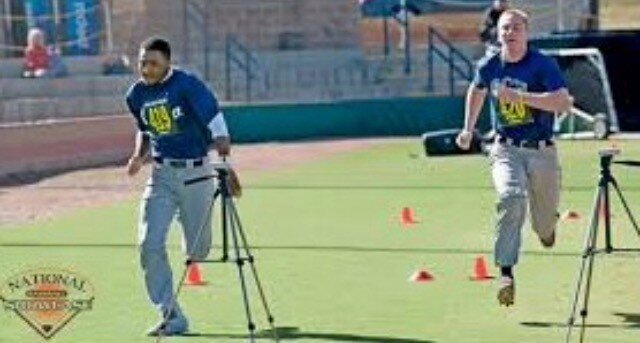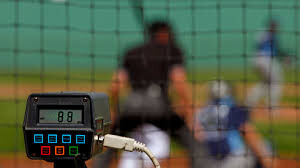
As a parent who has gone through the college recruiting process, I believe showcases are probably the single best dollar investment for those aspiring to play college baseball. But how to stand out at a baseball showcase is an often ignored topic and too many young athletes are attending showcases just to attend.
Many years ago when my son was 13 years old he was playing for a travel team out of Pennsylvania. The head of his travel organization knew college baseball recruiting inside and out. He made a point that summer that stayed with me over the years. It went like this “if you are going to a showcase make sure you have something to show”. He would say this over and over again. I knew what he was saying but as a first time parent I didn’t fully get it.
I was certainly willing to go wherever, whenever to get exposure for my son. But the reality is, it all adds up, and before you know it you have spent tens of thousands of dollars travelling up and down the East coast. Please don’t misunderstand me. I would do it all over again. But I would do it differently. I should say that the following comments are my opinions and based on my personal experience. I am sure there are those who disagree with some of my conclusions. Everyone’s experience is different but I do believe that there are some common themes in this process that most parents should know.
So here we go, the Top 5 things I learned about how to stand out at baseball a showcase travelling up and down the East Coast for over 5 years with my son, while he played for Evoshield Canes Mid-Atlantic (now US Elite) and Tri-State Arsenal Showcase 1.
-
- Size Matters but Athleticism is What Coaches are Looking For
- Best Time to Attend Showcases
- Types of Schools Attending the Showcase
- How You Conduct Yourself Speaks Volumes
- Metrics Matter
Here we go…
1. Size Matters but Athleticism is What Coaches are Looking For
Yes, it’s true, size does matter. A 6’4” pitcher with long arms should have a later release point at full extension. And if you apply pure physics, the speed of his hand at the tip of his fingers should be faster, with all else being equal. In addition, the ball has less of a distance to travel until it reaches the batter. So, yes size does matter, and it sure can help make you standout. But it isn’t everything.
We all know baseball is a game of failure, so on any given day at a showcase, coaches may not have a lot to go on. With that in mind coaches are trying to figure out which players to put on their follow list. It’s a very difficult process (for them and for us as parents). Frankly, given the number of players looking to play past high school the coaches are quick to move on to the next player.
So, if you aren’t the tallest, or the biggest, then you better be fast. If you aren’t the quickest then you better have high exit speed. If you aren’t throwing high velocity as a pitcher well you better show the potential for it. I am not saying that if you aren’t a certain height forget about attending showcases. But, I am saying that you better have other tools.
Being in the business, I sometimes see the same pitcher show up over and over at different showcases throwing 79 mph, yes over and over. Then he is wondering why there is no interest. I see outfielders running 7.5 sec 60-yard dashes and wonder why no one is interested. I see catchers with 2.5 “pop” times with no interest, wondering why there is no interest. And they keep showing up at events putting up the same exact numbers. Do you see a pattern here?
If you want to know how to stand out at a baseball showcase, regardless of height and size, you better start working on your ATHLETICISM, and get bigger, faster and stronger. Believe me when I tell you the coaches notice when a player shows physical improvements over time. We experienced this first hand as my son developed and matured physically.

2. Best Time to Attend Showcases
Show cases are now pretty much a year-round event. But, I think there is a time to go and a time NOT to go. Here is how I would rank their timing, from best time to worst time.
Summer Showcases – Summer is without a doubt the best time to go to showcases. Hopefully by then you have had a great high school season and have already had plenty of reps on your summer travel team. By then, the weather has warmed up, and for a player or a pitcher there is nothing better than playing in warm weather. It helps you loosen up, relax and hopefully run faster, throw harder and hit farther.
Fall Showcases – Fall showcases can be tricky. If you are a pitcher and you have had a long season with no rest, it’s very likely that your velocity is down from your peak by 3-5 mph. If this is the case, then skip all fall showcases. You will hear things like coaches don’t care, they know it’s the fall and you have had a long season. They want to see you. Well, unfortunately the pitchers that the coaches always notice are the ones throwing gas. And there are always those who took care of their body and arm all year long and then rested in August. They will probably show up and continue to throw their max velo, even in October.
Winter Showcases – With the exception of possibly mid- to late-February after a complete off-season program, winter events are a less optimal time to attend a showcase. You have had a long season, and you are being told to attend a November or December showcase. Frankly, at this time during the year, you should be taking a break from the game or you should be half-way into your off-season training. You are likely still mentally drained having played all year. So, skip the winter showcase, get some rest, recover, get bigger, stronger, faster. There are better times to show your abilities. Showcase yourself when you have had a chance to replenish and you have had plenty of reps and are ready, not only physically, but mentally as well.
However, it goes without saying that everyone’s situation is different. If you are an uncommitted senior looking to play college ball, or you stopped playing in August and began your off-season training in September my comments and conclusions above may not be applicable to you. As they say in golf “your lie dictates the shot”.
3. Types of Schools Attending the Showcase
One of the most important aspects of figuring out which showcases are the right ones for you to attend is to better understand which colleges might be attending. Some showcases list the colleges in advance on their website (if they don’t ask for it or look at prior year’s list as an indicator). Some showcases highlight their academic focus. Some showcases are local and others more regional. Here are some thoughts:
Academic vs. Regular – If you are looking for more academic schools then you should focus on academic showcases. There are many good ones where coaches from academic schools come to watch players. Their first question often is “what’s your SAT score?” Without it they don’t have much to go on. Every school is looking for different levels of scores. The little secret, however, is that depending on the school, the coach can always get one or two exceptions through the system if the scores are close enough.
Southern Schools – Here is a simple fact, if you want to play for southern schools you should be aware of two things.
First, schools tend to recruit locally. I asked a college coach once why that is the case. Here is what I heard, which makes sense. Coaches like to recruit players that fit the school’s mold. And more often, but not always, schools have a local flavor to them. Having said that, none of this really applies to pitchers. If you are an accomplished pitcher, most coaches will consider you regardless of where you come from. Furthermore, Southern coaches do like NE arms, possibly thinking they have more left in them and less likely to get injured.
Second, southern schools don’t really come north to recruit. You need to go to them.
Showcases are For-Profit Businesses – Let me say that again, showcases are for-profit businesses. They simply provide a service, it’s up to you to do your homework and decide which ones are right for you.
4. How You Conduct Yourself Speaks Volumes
It really is true. Coaches are watching all the time, even when you don’t think they are (as in off the field). But they watch mostly when you are on the field and in the dugout.
They love the players that sprint on and off the field. They absolutely can’t stand players that walk on and walk off like it’s a stroll through a mall. They care that you are well groomed. They care that your shirt is tucked in. They want you to wear your baseball hat like a ball player and not like a rap artist. They watch to see how you react when you strike out or when you walk 2 batters in a row. They want to see you fail and put it back together. They watch your behavior in the dugout with other players. They want you to approach them directly and express interest and they most definitely want to hear from YOU, not your parents. And one last thing, put a smile on your face. It speaks volumes.
5. Metrics Matter
Clearly metrics matter, but here is what I didn’t know. When you go to a showcase the first day is all about metrics, pitching velocity, 10, 30 or 60-yard dash, arm speed, pop-time, and bat and exit speed. What I didn’t realize is that the very next day the coaches often receive a summary list of all the players’ data, summarized and nicely sorted for them by the showcase company, from best to worst.

Let me ask you this – who do you think coaches would want to focus on when showcase playing time begins? Yes, the players at the top of the metrics lists, those with the fastest running speed, highest exit velo, highest pitching velocity (and highest SATs and GPA if they are academic schools). The rest of the players might just get ignored, unless of course you get lucky and put one over the wall.
How to stand out at a baseball showcase?
If your metrics (academics included) aren’t what they should be for the type of school you would like to play for, then save your money, skip the showcase and get back to work. As I mentioned earlier, I believe that showcases are probably the single best dollar investment for those aspiring to play college baseball. Just make sure you they fit your profile, your timing is right and most importantly, make sure you have something to “show”.
Other related articles:
By Bahram Shirazi (BSEE, MBA, Co-owner at RPP)
If you’d like to be added to our email list, please enter your information below!

